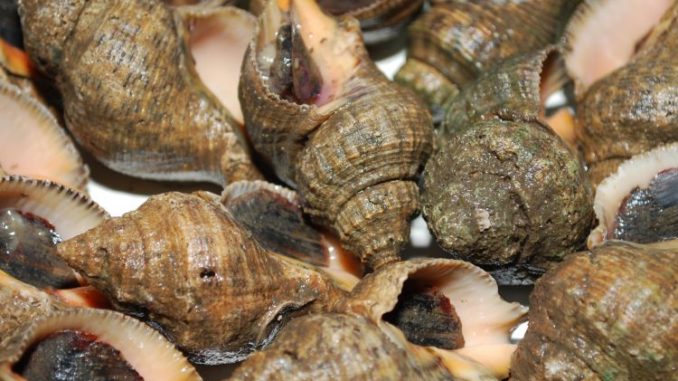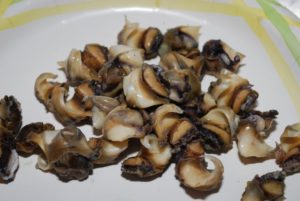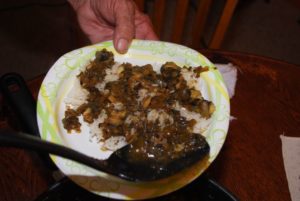
(and the fiercest oyster predator in the state)
There’s a vicious predator out there.
It lurks deep in Louisiana’s vast coastal marshes.
It hunts by day and it hunts by night, following the faintest scent trail to its prey. When it finds a victim, in this case a helpless oyster, it may take all day to subdue its prey. When it can’t get the job done by itself, it calls in others of its kind to overwhelm the creature.
It is relentless — and it’s a snail.
Called a conch (pronounced “conk”) by Croatian oystermen, a “bigorneaux” by Cajun oyster harvesters and an oyster drill by the rest of us, this humble creature is the fiercest oyster predator in Louisiana.
Scientists estimate that oyster drill infestations prevent oyster culture on half of all suitable bottoms in the northern Gulf of Mexico. Oyster reefs, besides providing delectable eating in the form of oysters, are prime fish habitat of interest to sports fishermen.
Its shell, not exactly a shell collector’s delight, is a nondescript tan mottled with brown, and is up to 4 inches long. The largest specimens in its whole U.S. range come from Louisiana.
Below 54º F water temperature, most of them will bury themselves in the mud. Even at perfect water temperatures and salinities, half of the population of drills will be buried at any one time.
The hunt and the kill

Oyster drills crawl easily on the softest of mud bottoms, but on hard surfaces can zoom along at the lightning speed of 10 feet an hour if they smell an oyster up-current. A drill’s muscular foot is divided into two halves, and the muscle on each side moves forward in alternating waves.
As it moves, it waves its snout-like siphon from side to side “smelling” the water for prey. Oyster drills are most noted, naturally enough considering their name, for drilling round holes through the shells of oysters, mussels or clams.
Drilling is a poor word because no rotary motion is involved in making the hole. Rather the snail’s snout holds what is called a radula, which looks very much like a J-shaped file or wood rasp.
The drill works this in a rolling, up and down motion to rasp its way into its victim’s shell. Once the shell is perforated, the snail uses the teeth on the radula to tear flesh loose, essentially eating the oyster from the inside out.
Apparently drills have other means of killing oysters. When scientists confined drills in cages with oysters, most were killed by the drill creating a very tiny, almost unnoticeable, slit-like hole on the edge of the shell. A significant number were also killed and eaten somehow with no damage to the shell.
A single drill can kill 1,000 to 3,000 oysters in its lifetime. Oyster drills often eat in groups, with as many as eight drills being found feeding on one oyster.
Oyster drills also eat mussels (probably their most preferred prey), clams, barnacles and even each other when they are hungry.
What kills drills?
Besides humans, oyster drills have very few predators. Cold simply makes them become dormant. At temperatures below 50º F, they stop feeding and bury themselves in the mud until temperatures warm.
Each drill comes equipped with an operculum made of shell attached to its foot. Dormant snails, as well as those exposed to air by stranding and those suddenly flushed by fresh or low-salinity water, seal themselves in their shell by plugging its opening with their trapdoor-like opercula.
The one thing that will kill oyster drills in large numbers is low-salinity water, especially when salinities plunge quickly because of springtime river floods. Large adult drills have been found as far as 50 miles offshore, where full strength seawater salinities of 35 parts per thousand (ppt) exist.
However, salinities of lower than 10 ppt will kill drills under any conditions. The faster the plunge in salinity occurs, the less that drills are able to cope with it. It is generally accepted that under normal conditions, oyster drills will only be found naturally at salinities of 18 to 20 ppt or higher. Massive river floods can almost exterminate drills from large areas of marsh.
They have a weird lifestyle
Oyster drills have separate sexes, but strangely, both males and females have penises, although they are nonfunctional in females.
Spawning starts at 70º F, typically in April or May and extending into June. After fertilization, females glue huge masses of leathery, pale yellow egg capsules on virtually anything solid.
Each capsule contains from 500 to 900 eggs, and one female may produce 10 million eggs in her lifetime. The free-floating larvae that hatch from the eggs are quickly spread by currents and tides to repopulate areas where adults have been decimated by fresh water floods.
So what good are they?

No fish eat drills, so they are useless as bait. But depending upon how adventurous one’s palate is, they are rated good to excellent as human food. They are best removed from the shell by boiling them a few minutes in salted water, ready to remove when their opercula begin to fall off their feet.
The flesh can then easily be pulled from the shell with a fork or a toothpick. The large sack of viscera can be easily pulled off the rear of the edible foot muscle and discarded.
Most people also remove the head by looking for the small antennae stubs at the base of the foot, then with their fingernail beneath the head, pulling it toward the tail.
Like all snails — escargot, abalone or true Caribbean conch, drills have relatively tough flesh that benefits from tenderizing or long cooking. In the 1950s a Louisiana company tried canning them commercially. The flavor was acceptable, but canning caused the meat to discolor and the project was abandoned.
Back in the day, before the modern oyster fishery existed, oystermen attempted to control drill numbers on their leases by attaching palmetto leaves to wooden poles. These were staked into the bottom on their reefs during the spawning season for drills.
Periodically, the oystermen pulled the leaves and destroyed the eggs and adult snails, minus the snails kept for personal consumption.


